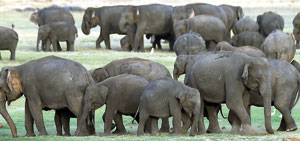Forewarned is forearmed and as the country faces unusual weather patterns and rains when there should be none, resulting in reservoirs and tanks in the dry zone filling to the brim, conservationists have sent out an alert that elephants may be in trouble.
Hundreds, nay thousands have seen large elephant herds of females and babies converging on the tank beds lush with young short grass during the dry season and researchers have expressed grave concern that if their access to this “valuable resource” is suddenly cut off, disastrous will be the consequences.
While elephant-herds are drawn to all grasslands in the Dry Zone tank-beds during the dry season for foraging, the most famous and considered to be one of its kind in Asia is ‘The Gathering’ on the Minneriya-Kaudulla tanks in the north-central region which attract a large number of foreign and local tourists.
Among the other such well-known tanks where ‘gatherings’ occur are the Parakrama Samudraya and the Kalawewa in the north-central region; the Gal Oya and the Maduru Oya in the east; and the Uda Walawe and Lunugamvehera in the south, the Sunday Times understands, many of them located within National Parks or sanctuaries.
“Usually the rains stop in January and the release of water from these reservoirs to smaller wewas for cultivations occurs in May-June-July,” says Dr. Prithiviraj Fernando of the Centre for Conservation and Research (CCR), explaining that with the gradual lessening of water levels the reservoir-beds become grasslands.
As the elephants have grown up in this environment for generations, they have adjusted to a particular pattern of resource change. In the dry season, they use the grasslands on the tank-beds extensively as young grass is an excellent food source and because the jungles offer less and less due to the drying up of the vegetation.
This year, however, there has been a change with unexpected rains due to climate change, he points out, stressing that if the reservoirs remain full there will be no grasslands for the elephants to feed on.
Delving into specifics on ‘The Gathering’ at Minneriya-Kaudulla, wildlife biologist Manori D. Gunawardena of the Dilmah Conservation Trust says that she has identified as many as 600-700 elephants in the Minneriya-Giritale-Kaudulla, Parakrama Samudraya and Hurulu area. Among them are 383 cow elephants and about 70 large adult bulls.
Ms. Gunawardena who did a pilot research project in the area in 2008, later conducted an individual elephant identification in 2009 and 2010, the Sunday Times learns.
Tracing the walkabouts of the herds of elephants in the area, she says that during the wet season from October to March the elephants roam in the Hurulu Forest Reserve because here grows high manna grass like that found at Uda Walawe.
This pattern of habitat use has been confirmed by radio-tracking studies done by the Department of Wildlife Conservation and the CCR, the Sunday Times learns.
In the dry season from April to October, however, the grass in the Hurulu Forest Reserve withers and dries up and then the elephants come in search of the grasslands, with shorter grass, which adorn the muddy, slushy tank-beds. The grass emerges after the draw-down of water, with the water being released to the farmers, she says. There is a misconception that the elephants gather on the tank-bed for the water but it is for the grass that they come. Vegetation in other areas has dried up and it is on the tank-bed that they forage.
Referring to a herd which includes seven-year-old Kasyapa (Ms. Gunawardena has named some elephants after kings and others after gods) in Minneriya, she says there are 47 in that, 16 adult females and the others babies. Another 73-member herd which includes Kali who is in her 30s, in Kaudulla has about 28 females.
‘The Gathering’ is so spectacular and unique that National Geographic was in Kaudalla just last year with filming crew et al and the elephants will be on television in Australia and Asia in the summer, according to Ms. Gunawardena.
The Sunday Times posed the hypothetical question what if there is surplus water in the reservoirs and it is not released preventing the grasslands from making an appearance?
Tragic will be the fallout, was the view echoed by both Dr. Fernando and Ms. Gunawardena who are not “clinical” researchers alone but elephant lovers working for the conservation of these majestic animals and spending long and weary days with them in the field.
Without food, the first casualties will be the babies, the Sunday Times learns. “The babies will die,” pointed out the researchers, and the human-elephant conflict will escalate in the surrounding areas. For lack of food, the elephants will be compelled to raid home gardens and paddy fields more and more, in turn not only becoming victims of human wrath but also making humans victims as well.
When asked for numbers, Dr. Fernando said a couple of thousand elephants will be affected around Sri Lanka.
In the case of reservoirs within the National Parks such as Minneriya and Kaudulla, the other major effects will be the loss of income to the country from tourists who come just to see and enjoy ‘The Gathering’, where they can get very close to elephants, a phenomenon that cannot be experienced elsewhere. A side-effect will be loss of income trickling down to people such as jeep drivers.
It will be an economic disaster, said another source, with many others agreeing that the loss in rupees and cents will be huge.
Many have been the attempts to position Sri Lanka as an alternative to the great African safari and the country is about to reap dividends now that the conflict is over, according to many hoteliers who are attempting to promote ecotourism.
Among the great stories that broke out here which caught the attention of the nature loving world were Yala's leopards, Sinharaja, the blue whales and the spectacular ‘Gathering’ that occurs as predictably as the Great Migration of Africa, according to the Head of Eco Tourism and Special Projects, John Keells Hotels Group, Chitral Jayatilake.
Nowhere in Asia is a place where one can observe 300 Asian elephants gathered on a single evening, frolicking and grazing. This is on many nature tourists’ calendar, he says, adding that nurturing this mega wildlife super-show, will no doubt help position Sri Lanka as a top wildlife destination. It will attract the top shelf of tourists and photographers, filling many room nights.
The much-needed revenue thus generated will aid conservation and create job opportunities for rural folk, says Mr. Jayatilake.
Travel industry professional Srilal Miththapala said while the Irrigation Department should be aware of the situation the need is to strike a healthy balance between the elephant issue and the benefits that will be reaped by the farmers.
There certainly is a huge value addition to tourism in the Cultural Triangle due to the ‘Gathering’, he concedes.
Balance there must be -- the answer is to lower the levels in these reservoirs and let at least a part of the grasslands appear, it is argued, because anyway there will be showers during the next wet season and the tanks will fill up once again.
No reason for alarm assures DG Irrigation Dept.
The 60 major reservoirs under the Irrigation Department is at full-supply level or just below, said its Director-General Dr. (Eng) G.G.A. Godaliyadda when the Sunday Times contacted him on the crucial situation that could arise.
Explaining that in his experience (one year as DG and 36 years in the department) he feels that such a drastic situation may not arise and they were empathetic towards the plight of the elephants and open to discussion, he said the department had begun releasing water for yala cultivations.
 |
| DG Godaliyadda |
The release of water from some tanks began end March and beginning of April and also after Avurudu, he said.
Going into the nitty-gritty of the cultivation seasons, Dr. Godaliyadda said maha cultivations are carried out during the rainy season and therefore 100% of the land is farmed. However, as yala is during the dry season only about 40-50% of the land is usually cultivated. Due to the unusual rains because the tanks are full now, we are hoping to give water for 100% of the lands to be cultivated this yala.
Drawing detailed diagrams about the topography of the tanks and calculating the acre-feet of water required for the yala cultivations along with the Director of Water Management, H.M. Jayathilake, the DG said data collected early this month indicate that of the 60 major tanks 12 have water at 100% of capacity, 42 have between 75-100% and six between 50-75%.
Usually, during yala only 50% of the 680,000 acres are cultivated, using about 5 acre-feet of water per acre. But this year, the aim is to cultivate all using the three million acre-feet of water available in the tanks. “Don’t worry. The grasslands on the tank-beds will open up for the elephants,” he said. |



